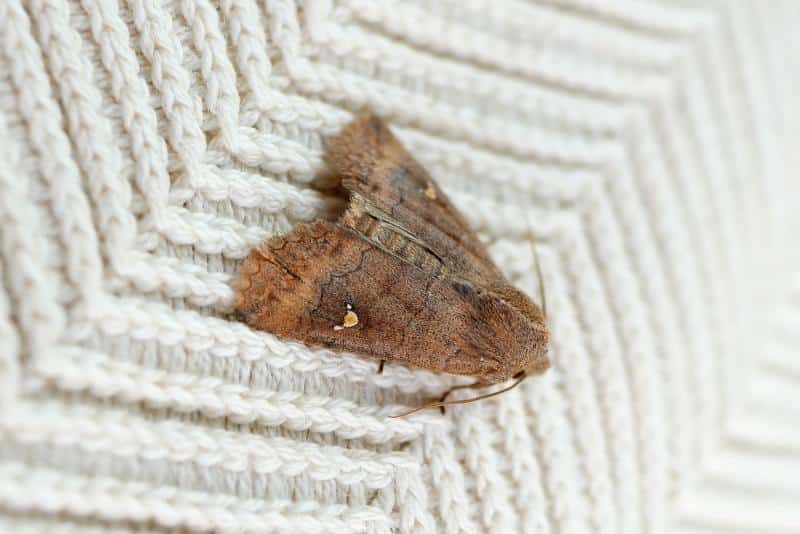Moths, while seemingly harmless, can quickly become a nuisance in any home, leaving behind damaged fabrics and contaminated food. Notorious for their persistence, these uninvited guests require more than just a swat or a spray to keep them at bay for good. Understanding what attracts them and preemptive measures are key to controlling their invasion.
In this guide, we’ll share six proven tips that will help you not only get rid of moths effectively but also prevent their return, ensuring your home remains moth-free and your belongings intact. From natural remedies to practical preventative steps, these tips are designed to provide you with a comprehensive strategy for moth control.

Clean Regularly
Moths are particularly drawn to dirty and dusty environments, which provide optimal conditions for their larvae to thrive. Regular cleaning is, therefore, essential to prevent moth infestations. Focus on vacuuming and dusting areas that are often overlooked, such as closets, under furniture, and corners of rooms. Washing floors and wiping surfaces with a vinegar solution can also deter moths, as they dislike the smell. It’s especially important to clean the nooks and crannies where moths may lay their eggs.
Proper storage of clothing and textiles is another critical step in moth prevention. Moths are attracted to natural fibers like wool, silk, and fur. Before storing clothes for long periods, such as seasonal items, make sure they are clean and completely dry. Using airtight containers or vacuum-sealed bags can further protect your items from moths. Adding natural repellents like lavender sachets or cedar blocks in your closets and drawers can also ward off moths, as they dislike these scents.
In the pantry, ensure that all food items are stored in airtight containers to prevent moths from invading. Pantry moths are drawn to grains, cereals, nuts, and flours. Regularly inspect your pantry for any signs of moth activity, such as webbing or larvae, and dispose of infested items immediately. Keeping your pantry organized and clutter-free not only makes it easier to spot signs of moths but also reduces their hiding spots. Consider incorporating bay leaves in pantry shelves; their scent is known to repel moths.
Professional Pest Control
When all else fails, or if the infestation is beyond DIY solutions, hiring professional pest control services can be a necessary step. Experts in pest control are equipped with the knowledge and tools to effectively tackle severe moth infestations, using strategies that are safe for your home and family. To quote the people from ORKIN, when you see a pest, you want it gone fast. Regular pest control services can also offer preventative solutions to ensure moths do not return, providing peace of mind and a moth-free environment.
Use Cedar and Moth Traps
Cedar has natural properties that repel moths, making it an excellent, natural option for protecting your clothes and belongings. Placing cedar blocks, balls, or chips in closets, drawers, and storage boxes can keep moths at bay without resorting to chemicals. Over time, the scent of cedar fades, so sanding the surface of cedar items or adding a few drops of cedar oil can rejuvenate their effectiveness in repelling moths.
Moth traps are an efficient and non-toxic way to catch adult moths and prevent them from reproducing. These traps typically use pheromones to attract the moths, which then become stuck to the adhesive inside the trap. It’s important to place these traps in areas where moths are commonly found, such as closets, pantries, and near wool or silk items. While traps won’t solve a large infestation on their own, they can greatly reduce the moth population and are a vital tool in monitoring areas for activity.
Moths thrive in warm, humid conditions, so keeping your home cool and dry is an effective way to deter them. Using dehumidifiers in damp areas of your home, such as basements and attics, can create an environment that is less appealing to moths. Additionally, regular airing out of stored textiles, especially during dry, sunny days, can help prevent moths from settling in. Ensuring good ventilation throughout your home also helps in keeping it dry and less attractive to moths.
Secure Food Containers
Moths often enter homes looking for food. Pantry moths, in particular, are attracted to grains, nuts, flour, and other dried goods. Storing food in airtight containers can prevent moths from scenting and accessing these food sources. Glass or metal containers with secure lids are ideal, as they offer no way for moths to penetrate and contaminate your food. This practice not only deters moths but also helps in maintaining food freshness. Additionally, regularly checking expiration dates and discarding old or expired food items can also prevent moth infestation.

Use Moth Traps
Moth traps are a non-toxic way to catch and monitor moth activity in your home. These traps use pheromones or enticing scents to attract moths, trapping them on a sticky surface. Place the traps in areas where moth activity is suspected, like closets, pantries, or near entry points. Checking and replacing these traps regularly will provide insight into whether your moth deterrent efforts are working. If you notice a significant decrease in moth activity, it may be a sign that your methods are successful. However, if the traps continue to fill up quickly, you may need to adjust your strategy.
Maintain Outdoor Lighting
Moths are attracted to lights, especially bright outdoor lighting that can draw them towards and into homes. Opting for yellow or sodium vapor bulbs for outdoor lighting can reduce the attraction of moths, as these lights are less appealing to them. Additionally, considering the use of motion-sensor lights can minimize the time lights are on, thus reducing the period during which they can attract moths. Regularly cleaning outdoor lights and avoiding using light sources near open windows can also help prevent moths from entering your home.
In summary, managing and eliminating moth infestations requires a multifaceted approach that combines cleanliness, proper storage, the use of natural repellents, vigilant monitoring, and adjustments to household lighting. By integrating these strategies into your everyday routines, you can create an inhospitable environment for moths, safeguarding your belongings and food from damage and contamination.
Consistency is key in prevention and maintaining a moth-free home. However, should you encounter an overwhelming infestation, do not hesitate to seek professional pest control services for a comprehensive and effective resolution. With patience and persistence, you can enjoy a clean and moth-free living space.
